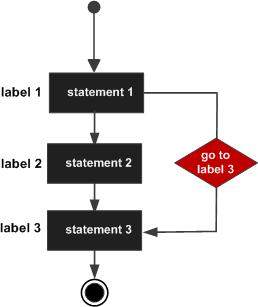
- PL/SQL - Home
- PL/SQL - Overview
- PL/SQL - Environment
- PL/SQL - Basic Syntax
- PL/SQL - Data Types
- PL/SQL - Variables
- PL/SQL - Constants and Literals
- PL/SQL - Operators
- PL/SQL - Conditions
- PL/SQL - Loops
- PL/SQL - Strings
- PL/SQL - Arrays
- PL/SQL - Procedures
- PL/SQL - Functions
- PL/SQL - Cursors
- PL/SQL - Records
- PL/SQL - Exceptions
- PL/SQL - Triggers
- PL/SQL - Packages
- PL/SQL - Collections
- PL/SQL - Transactions
- PL/SQL - Date & Time
- PL/SQL - DBMS Output
- PL/SQL - Object Oriented
PL/SQL - GOTO Statement
A GOTO statement in PL/SQL programming language provides an unconditional jump from the GOTO to a labeled statement in the same subprogram.
NOTE − The use of GOTO statement is not recommended in any programming language because it makes it difficult to trace the control flow of a program, making the program hard to understand and hard to modify. Any program that uses a GOTO can be rewritten so that it doesn't need the GOTO.
Syntax
The syntax for a GOTO statement in PL/SQL is as follows −
GOTO label; .. .. << label >> statement;
Flow Diagram

Example
DECLARE
a number(2) := 10;
BEGIN
<<loopstart>>
-- while loop execution
WHILE a < 20 LOOP
dbms_output.put_line ('value of a: ' || a);
a := a + 1;
IF a = 15 THEN
a := a + 1;
GOTO loopstart;
END IF;
END LOOP;
END;
/
When the above code is executed at the SQL prompt, it produces the following result −
value of a: 10 value of a: 11 value of a: 12 value of a: 13 value of a: 14 value of a: 16 value of a: 17 value of a: 18 value of a: 19 PL/SQL procedure successfully completed.
Restrictions with GOTO Statement
GOTO Statement in PL/SQL imposes the following restrictions −
A GOTO statement cannot branch into an IF statement, CASE statement, LOOP statement or sub-block.
A GOTO statement cannot branch from one IF statement clause to another or from one CASE statement WHEN clause to another.
A GOTO statement cannot branch from an outer block into a sub-block (i.e., an inner BEGIN-END block).
A GOTO statement cannot branch out of a subprogram. To end a subprogram early, either use the RETURN statement or have GOTO branch to a place right before the end of the subprogram.
A GOTO statement cannot branch from an exception handler back into the current BEGIN-END block. However, a GOTO statement can branch from an exception handler into an enclosing block.